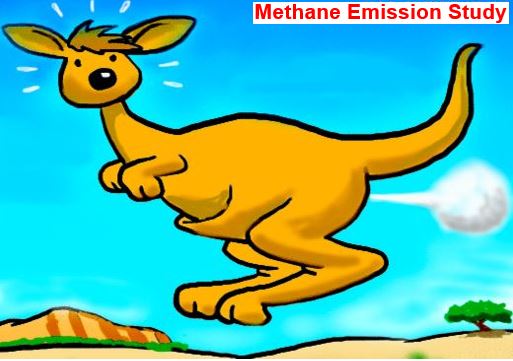A kangaroo fart study carried out by a team of Australian and Swiss scientists has turned previous research on its head. They say theirs is the most comprehensive research to date investigating methane emissions from Australia’s biggest marsupials.
How much methane kangaroos produce has long been a subject of much debate. Now we know, thanks to work led by Dr. Adam Munn, from the University of Wollongong’s Institute for Sustainable Ecosystem Solutions, and Prof. Marcus Clauss, from the University of Zurich’s Clinic of Zoo Animals, Exotic Pets and Wildlife.
The research was carried out by Catharina Vendl, a PhD student and veterinarian, at the Fowlers Gap Arid Zone Research Station, part of the University of New South Wales.
 Kangaroos emit much less methane than domestic ruminants.
Kangaroos emit much less methane than domestic ruminants.
They published their findings in the peer-reviewed publication The Journal of Experimental Biology.
Dr. Munn said:
“We knew that the kangaroos would produce little methane, but certainly not zero, and the question remained as to why.”
Methane released into our atmosphere plays a major role in the production of greenhouse gas emissions, which contribute to global warming.
Study challenges previous research
Dr. Munn added:
“The main hypotheses behind kangaroos producing little methane have focussed on kangaroos having a unique microbiome that produces less methane, mainly from flatulence rather than burping like cows and sheep. But, without wanting to burst the bubble of the microbiologists, our findings suggest otherwise.”
The researchers measured absolute kangaroo methane output, and compared it to that of horses, factoring in body weight.
Prof. Clauss explained:
“Kangaroos have a very different stomach from that of ruminants such as sheep and cows. We think that the methane is low because of the way food moves through the kangaroo stomach, and not because of a unique gut fauna.”
The scientists conclusion was based on the finding that how much methane is produced per ingested food varies, even within kangaroos, depending on how much they consume.
 Domestic ruminants emit enormous quantities of methane into the atmosphere.
Domestic ruminants emit enormous quantities of methane into the atmosphere.
It depends on what they eat, and how much
When the kangaroos were fed restrictively, methane per unit of food was nearly as high in some animals as values found in domestic ruminants (e.g. cattle).
Prof. Clauss and Dr. Munn say it is wrong to try to reduce greenhouse gas emissions from ruminant livestock by replacing their gut fauna with that from kangaroos or other animals that emit lower quantities of methane. They believe that approach will ultimately fail.
The findings from this latest study add to the team’s research into wildlife methane emissions that seeks to understand the rules of methane production in a comparative approach by studying several different species.
So far, Dr. Munn, Prof. Clauss and colleagues have measured methane emissions from llamas, camels, rodents & rabbits, ostriches, horses, rheas, emus, sloths and kangaroos.
Further studies are require to fully understand why many of these animals emit lower quantities of methane compared to ruminants, Dr. Munn said.
In an Abstract in the journal, the authors wrote:
“Although our data suggest that kangaroos only produce about 27% of the body mass-specific volume of CH4 of ruminants, it remains to be modelled with species-specific growth rates and production conditions whether or not significantly lower CH4 amounts are emitted per kg of meat in kangaroo than in beef or mutton production.”
Citation: “Decreasing methane yield with increasing food intake keeps daily methane emissions constant in two foregut fermenting marsupials, the western grey kangaroo and red kangaroo,” Catharina Vendl, Marcus Clauss, Mathew Stewart, Keith Leggett, Jürgen Hummel, Michael Kreuzer & Adam Munn. Journal of Experimental Biology 2015 218: 3425-3434; DOI: 10.1242/jeb.128165.
